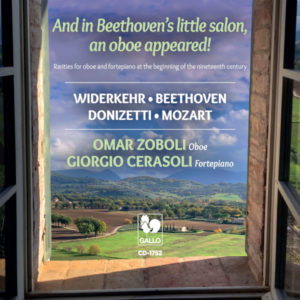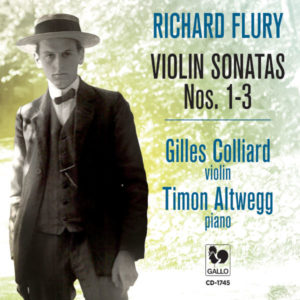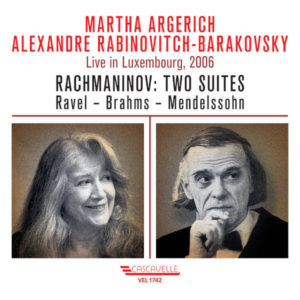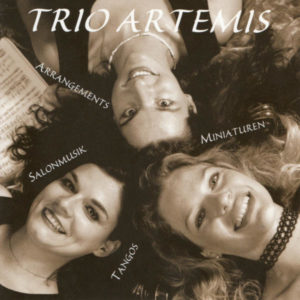Extraits / Excerpts
20TH CENTURY CHAMBER MUSIC FOR VIOLIN, CLARINET AND PIANO – LUIGI MAGISTRELLI – GIAMBATTISTA PIANEZZOLA – RUTA STADALNYKAITE
20th Century Chamber Music for Violin, Clarinet and Piano
Béla BARTÓK : Contrasts, Sz. 111 – Dmitri SHOSTAKOVICH : Five Pieces for Two Violins & Piano (Arr. by Luigi Magistrelli) – Nino ROTA : Lo spiritismo nelle vecchia casa – Darius MILHAUD : Suite, Op. 157B – Igor STRAVINSKY : 3 Pieces for Clarinet Solo – L’Histoire du Soldat.
Luigi Magistrelli, Clarinet – Giambattista Pianezzola, Violin – Ruta Stadalnykaite, Piano.
20th Century Chamber Music for Clarinet, Violin and Piano
Since ever the violin and the clarinet had been considered some of the most expressive instruments, having a real suitable soul capable to get out the inner feelings in a very effective way. So, I think that to put them together with a piano accompaniment had been a real fulfilment!The repertoire for this medium is not so large but we fortunately have a few small masterpieces to perform. Here on this compact we thought to record most of them.
All these compositions belong, not by coincidence, to the modern period and had been written by composers who had a high consideration of both, violin and clarinet, in the fields of orchestral and chamber music.
The Contrasts of Bartók is the most celebrated, difficult and interesting composition ever written for this instrumental combination. This Trio, written in 1938, was officially commissioned by Benny Goodman but then realized also in response to a letter of the well known hungarian violinist Joseph Szigeti. Both of them and the composer himself recorded the piece on a LP in 1940 and premiered it in New York in the same year.
Bartók wanted to put in this piece some dance folk melodies coming from the hungarian and rumanian traditions, mixing them and creating contrasting effects, above all considering the variety of dif ferent speeds. The indications of the three movements Verbunkos (Recruiting Dance), Pihenő (Relaxation), Sebes (Fast Dance) are quite important to understand their distinctive character. As somebody said, in this piece should be required a technical bravura and a poetic versatility too. It’s a very effective work with dynamic and tempo changes. A very demanding but also rewarding composition to perform.
Despite of the usual modern and experimental style of the compositions of chamber music of Shostakovich, his Five pieces for two violins and piano (here arranged using the clarinet in spite of second violin) are easy, melodical with very charming tunes.
Shostakovich was quite active also as a composer of russian movies sound tracks and these little beautiful gems are a very good example. The Spiritism of the old house originates from a play by Ugo Betti bearing the same name where a performance of a solo clarinet was required, so Nino Rota composed this music.
Rota is quite well known for his many sound tracks (50!) of movies also of very famous producers such as Luchino Visconti and Federico Fellini but also for the good quality of his chamber music production.
He included clarinet in a Nonet for strings and winds, a Clarinet Sonata with piano and a nice Trio with clarinet, cello and piano. He also composed music for eight ballets and eleven operas. His style is very traditional, melodical and essential being so of ten connected, as above written, with the movie music.
The Suite of Darius Milhaud expresses, like many other french composers, the love he had for wind instruments and the clarinet in particular. After the first world war the neo-classic tendency reappered and winds instruments were of ten chosen for this goal.
Milhaud however wrote this nice Suite in 1937, one year before the Bartók Contrasts. Also here in the four relatively brief movements contrasting moods are represented with lighthearted witty, melancholic and extrovert different characters. A pure fun both for the listeners and the performers! As of tenhappened, also in the case of the Three pieces for clarinet alone (the manuscript bears the title Music pour solo clarinette) was published in 1919, shortly af ter the completion of his Suite from L’Histoire du Soldat, as a thank you gift to the philanthropist and arts patron Werner Reinhart, who was also an amateur good clarinetist from Winterthur (Swizerland) who was wealthy and very enthusiast about new clarinet compositions. Also Histoire du Soldat was supported by his financial help. He was even able to involve Webern and Berg with some compositions of theirs including clarinet. The Three pieces for clarinet alone are short but very well conceived and meaningful miniatures and once again depicting three different situations. The first is meditative, the second improvisatory and the third with jazzy style strictly connected with the Histoire du Soldat. Which instrument could do a better job than a clarinet? The Suite of the Histoire du Soldat for seven instruments, based on a Russian folk tale drawn from the collection of Alexander Afanasyev called The Runaway Soldier and the Devil, was arranged by the composer himself for violin, clarinet and piano also reducing to five the number of the usual eight movements and the first performances occured in Lausanne, Zurich and Geneva in 1919 with Josè Porta, as violinist, Edmund Allegra (not Reinhart!) and Josè Iturbi as pianist. The overall outcome is not less effective and demanding, using only three instruments instead of seven!
Luigi Magistrelli
- Categories
- Composers
- Interprets
- Booklet













